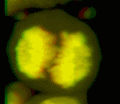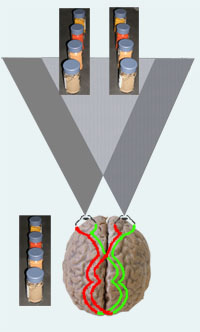The word "stereo" originates from Greek and meant "in relation with space". In this short writing some terms about depth vision are introduced as far as they might be helpful to the understanding of acquisition and rendering of xyz-images in microscopy. For further information,please follow the links in the text below to specialized sites elsewhere.
| Anaglyph animation with depth impression[ |
 |
| Microscopical red-green anaglyph images corresponding to various projection angles have been mounted in a film sequence. From this series of images with depth information it can be determined that the daughter chromatides were already separated in this deviding cell (anaphase stage) |
Man has the ability to physically perceive depth and thus to be able to interprete three-dimensional arrangement of objects and movements in a spatial environment. In the course of evolution this ability must have been a great advantage for human beings to move, orient themselves and maintain themselves on earth. As a consequence of the position of both eyes next to each other, the retinas of the left and right eye perceive a largely overlapping image of the world, that however, shows some shift and a slight rotation angle with respect to each other:
retinal disparity. This phenomenon is called
parallax. In the visual cortex of the brain these two different images are combined to one unit. A sensation of depth vision arises (more about
binocular vision = vision with two eyes). In fact we do not deal with full 3D vision, since the field of vision is relatively narrow. Another restriction is that the perspective is determined by the place where the observer stays. According to the "
Optometrics network" at least 12% of people have some type of problem with their binocular vision. Remarkedly, with only one eye it is often still possible to make a good estimation of the spatial distribution of objects around us (this is also possible with other senses, by the way!): we can scan the surrounding by directing our eyes and head, while our eyes stepless focus on the shapes on which we concentrate. From this bulk of visual information coupled to earlier experiences, in particular distortions related to perspective, the size and significance of objects, we are able to re-create a "depth picture" in our head.
| Depth vision |
 |
Depth perception: phenomenon of parallax: our two eyes perceive two slight different windows of the world (see schematic representation).
Test: put a few objects (here jars with spices) at a distance of about 1 meter. Keep the head still and look alternately with the right and left eye at those objects (quickly alternate left and right): the objects (their view) seem to jump aside. When looking again with both eyes the two images appear in our impression to be automatically reconstitued to one quiet single unit. |  |
| Interpretation of depth from perspective and spatial context: in one wink it is possible to make up from this photograph which tree was the closest to the photographer and which ones were further away, even though the projection on the screen is in fact a flat image. From earlier experience, e.g. knowing the size of a swan, we can guess that the trees were big. |







